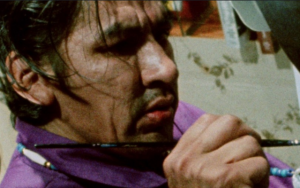THERE ARE NO FAKES: 4 STARS. “revelations of sex, drugs and exploitation.”
 Norval Morrisseau was once called “the Picasso of the North.” The Anishinaabe artist was a stylist whose unique vision created a new kind of visual storytelling. His bright colours and bold illustration brought traditional Indigenous stories to life in a way that made him famous and today he thought of as the grandfather of contemporary First Nations art in Canada.
Norval Morrisseau was once called “the Picasso of the North.” The Anishinaabe artist was a stylist whose unique vision created a new kind of visual storytelling. His bright colours and bold illustration brought traditional Indigenous stories to life in a way that made him famous and today he thought of as the grandfather of contemporary First Nations art in Canada.
A new documentary, “There Are No Fakes” from director Jamie Kastner, starts with the purchase of a $20,000 Morrisseau called “The Spirit Energy of Mother Earth.” Barenaked Ladies member and art collector Kevin Hearn purchased the painting in 2005, the same year the artist established a foundation to catalogue and authenticate all legitimate copies of his work. The painting hung on Hearn’s wall for five years until he loaned it to the Art Gallery of Ontario for public display. When the AGO raised doubts about the painting’s legitimacy, it was taken down. When Hearn questioned the dealer he bought the forgery from he was met with the phrase that gives the film its name, “There are no fakes.” Except there are. Possibly thousands of them.
The lawsuit Hearn filed against the dealer provides Kastner with the bedrock of the story. The film’s first half introduces a cast of characters worthy of any story of intrigue. From angry art dealers and Morrisseau’s earnest apprentice to lawyers under siege and an out-of-pocket Barenaked Lady, “There Are No Fakes” examines the murky world of high stakes art.
It’s in the movie’s second half that Kastner, through his investigative work, uncovers the sordid story behind the underground trafficking of fake Morrisseau art. It’s a journey that veers away from the tony galleries of Toronto’s Yorkville neighborhood to Thunder Bay and shocking revelations involving sex, drugs and exploitation.
“There Are No Fakes” is more than a simple procedural. Kastner carefully lays out the story, finding the rich corners in the personalities of his subject before slowing the film’s pace and tone for the explosive final disclosures. What begins as a document of a court case and its countersuits turns into something more important, more vital, as it underlines how Indigenous artists, even world-famous ones, have been exploited.
